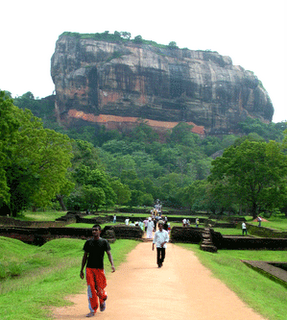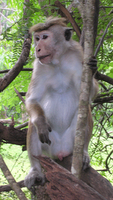Sigiriya ...The More Things Change
 Once upon a time on a beautiful island studded with precious jewels and gemstones, there lived a wicked king who stole his brother’s throne and drove him away. Then, he found the perfect site for an impregnable fort. No one could ever touch him there. So, he built Sigiriya—a great citadel atop a six hundred-foot high, sheer-sided rock. Around its base he laid out a beautiful city of palaces and gardens laced with pools and fountains, with streams and waterfalls.
Once upon a time on a beautiful island studded with precious jewels and gemstones, there lived a wicked king who stole his brother’s throne and drove him away. Then, he found the perfect site for an impregnable fort. No one could ever touch him there. So, he built Sigiriya—a great citadel atop a six hundred-foot high, sheer-sided rock. Around its base he laid out a beautiful city of palaces and gardens laced with pools and fountains, with streams and waterfalls.
Dee dah, dee dee dah … a recorded flute plays over and over in a minor key, sending an eerily appropriate sound over the ruins of Sigiriya. My daughter, her friend, Monique, and I sort through our money at a Department of Archeology kiosk. We need much more than we expected and have to pool our resources. Then, tucking water bottles into belt loops or back packs, we pass the source of the music—a motor rickshaw, its body transformed into an ice cream machine.
"And," our guide, Malik, says, "the king loved his creation so much that when his brother came back with an army, the wicked king took his own army out onto the plains rather than risk having his city destroyed. There, he was defeated, and he never saw Sigiriya again. The city for which he risked everything fell into ruins, only monks living in caves on the rock. Finally, even the monks left, and the city was forgotten, was eaten by the jungle."
The wicked king’s parks are laid out before us … the waterways and pools delineated by walls and filled now with grass kept low by wandering cows, its precinct a playground for monkeys. A roadway the width of an oxcart stretches toward the 600-foot high rock with its sheer sides and its crown of ruins. Minus the ruins, this is a Sri Lankan Devil’s Tower—older and half the height but with the same impressive presence.
The crowds here for the Christmas holidays spread out, children vaulting walls and playing tight-rope walker on their tops, adults strolling, teens checking out their peers—blue jeans and tee shirts as common as anywhere else in the world. Slowly, the laughter and chattering diminish, though, as the rock-paved road leads uphill until we’re in the shadow of "the rock." Sigiriya, itself, looms over us, seeming impossibly high.
Stairs funnel the crowds now. There’s no other way … just one flight of stairs after another with these lower sets ending at trails that snake away around the rock, accessing caves and overhanging shelters that once provided homes for monks.
"Buddhist monks lived here for centuries after the kings were gone," our guide, Malik, says. "Then came years of drought, and the farmers had to leave. The monks, with no one to feed them, left, as well."
The sound of rustling clothes and of leather and rubber soles on rock fills the air now in an otherwise hushed silence. Hundreds of us are climbing and climbing. One hundred meters up, we reach the "mirror wall" where frescos line one side of the trail. There’s only space for one person to move forward at a time here, and it’s a traffic jam—a tight press of bodies, those ahead be pushed forward by the stream of people coming up. At this point, my chest cold and my Wyoming need for elbow room tell me that I’ve had enough, and I take a lateral trail that will lead to the parking lot and the jungle—a route blessedly free of crowds.
Back at the bottom, I watch a troop of monkeys raiding a box of coconuts strapped to the top of a van. One by one, the audacious thieves scoop out the fruit, tossing the brown spheres to their fellows in nearby trees. Just so their remote ancestors probably raided kitchens when Sigiriya was inhabited. This thought provides a bit of perspective, a way to pass time until, sweat-soaked, Robyn and Monique reappear.

0 Comments:
Post a Comment
<< Home